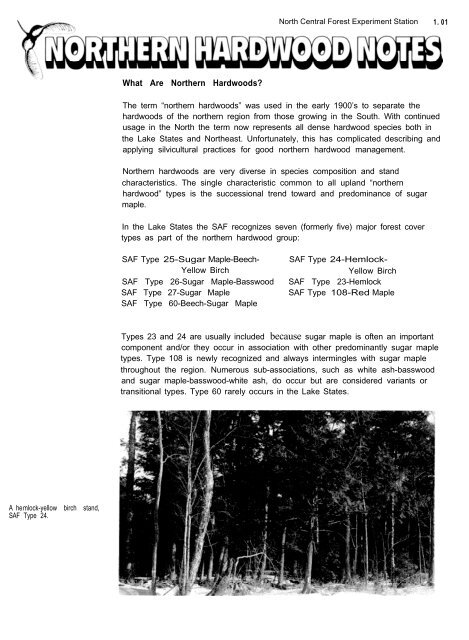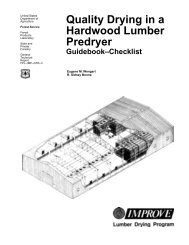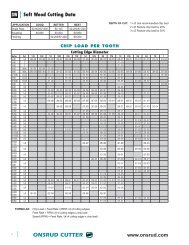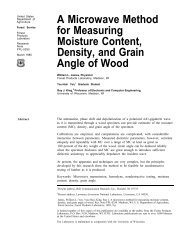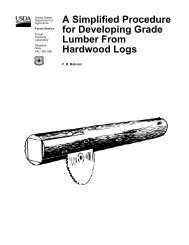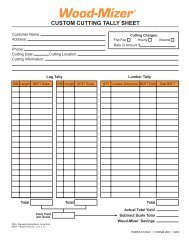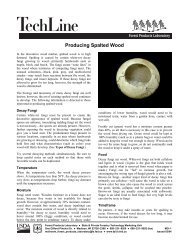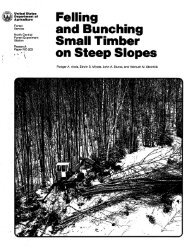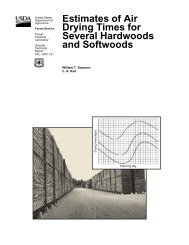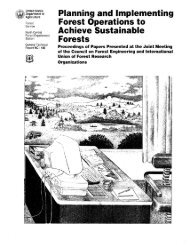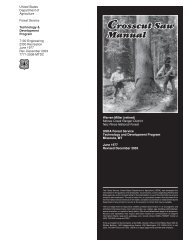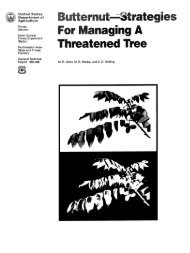What Are Northern Hardwoods? - North Central Research Station
What Are Northern Hardwoods? - North Central Research Station
What Are Northern Hardwoods? - North Central Research Station
You also want an ePaper? Increase the reach of your titles
YUMPU automatically turns print PDFs into web optimized ePapers that Google loves.
<strong>North</strong> <strong>Central</strong> Forest Experiment <strong>Station</strong> 1.01<br />
<strong>What</strong> <strong>Are</strong> <strong><strong>North</strong>ern</strong> <strong>Hardwoods</strong>?<br />
The term “northern hardwoods” was used in the early 1900’s to separate the<br />
hardwoods of the northern region from those growing in the South. With continued<br />
usage in the <strong>North</strong> the term now represents all dense hardwood species both in<br />
the Lake States and <strong>North</strong>east. Unfortunately, this has complicated describing and<br />
applying silvicultural practices for good northern hardwood management.<br />
<strong><strong>North</strong>ern</strong> hardwoods are very diverse in species composition and stand<br />
characteristics. The single characteristic common to all upland “northern<br />
hardwood” types is the successional trend toward and predominance of sugar<br />
maple.<br />
In the Lake States the SAF recognizes seven (formerly five) major forest cover<br />
types as part of the northern hardwood group:<br />
SAF Type 25-Sugar Maple-Beech-<br />
Yellow Birch<br />
SAF Type 26-Sugar Maple-Basswood<br />
SAF Type 27-Sugar Maple<br />
SAF Type 60-Beech-Sugar Maple<br />
SAF Type 24-Hemlock-<br />
Yellow Birch<br />
SAF Type 23-Hemlock<br />
SAF Type 108-Red Maple<br />
Types 23 and 24 are usually included because sugar maple is often an important<br />
component and/or they occur in association with other predominantly sugar maple<br />
types. Type 108 is newly recognized and always intermingles with sugar maple<br />
throughout the region. Numerous sub-associations, such as white ash-basswood<br />
and sugar maple-basswood-white ash, do occur but are considered variants or<br />
transitional types. Type 60 rarely occurs in the Lake States.<br />
A hemlock-yellow birch stand,<br />
SAF Type 24.
A mature sugar maple stand.<br />
SAF Type 27.<br />
Another hardwood type, SAF 39-Black ash-American elm-red maple, should also<br />
be mentioned. Dutch elm disease (see Note 7.03) has reduced the elms in many<br />
stands of this lowland hardwood type, resulting in a stand composed mostly of<br />
black ash and red maple.<br />
A lowland hardwood forest<br />
nated by black ash, SAF<br />
39.<br />
Type
Although many species may occur in northern hardwoods, the principal species<br />
nearly always include sugar maple, white ash, yellow birch, basswood, red maple,<br />
American elm, beech, and eastern hemlock. Occasionally aspen, paper birch,<br />
northern red oak, rock elm, ironwood, black cherry, and balsam fir are important.<br />
The northern hardwoods are thus a complex association of cover types and cannot<br />
be managed as a single entity like other recognized types.<br />
There are also regional differences in the northern hardwoods relating to species<br />
composition, climate, and soil. To best understand and manage the Lake States<br />
“northern hardwoods” we should avoid using this all-inclusive term and recognize<br />
instead the particular forest cover type on the area in question. How we manage<br />
depends greatly on which of the cover types we have. They determine such things<br />
as:<br />
1. Whether to use even-age or all-age practices.<br />
2. The optimum residual stocking to work toward.<br />
3. Whether site preparation will be needed to establish some species.<br />
4. <strong>What</strong> site index to consider (it can vary 5 to 15 feet among species on the same<br />
soil).<br />
5. <strong>What</strong> type of cutting to use to improve bole quality and increase the rate of<br />
growth.<br />
These questions will be addressed in the notes to follow.<br />
Reference<br />
Eyre, F. H. (editor). Forest cover types of the United States and Canada. Society of<br />
American Foresters; 1980. 148 p.<br />
Richard M. Godman<br />
3


